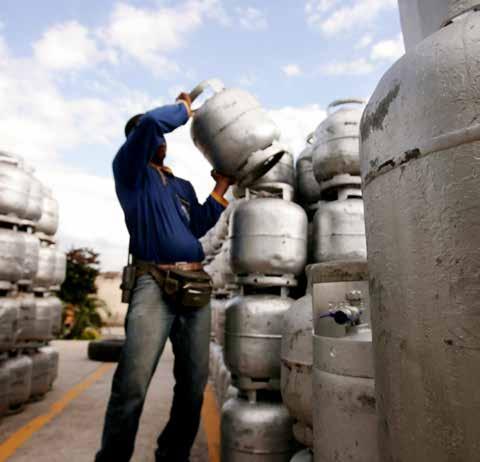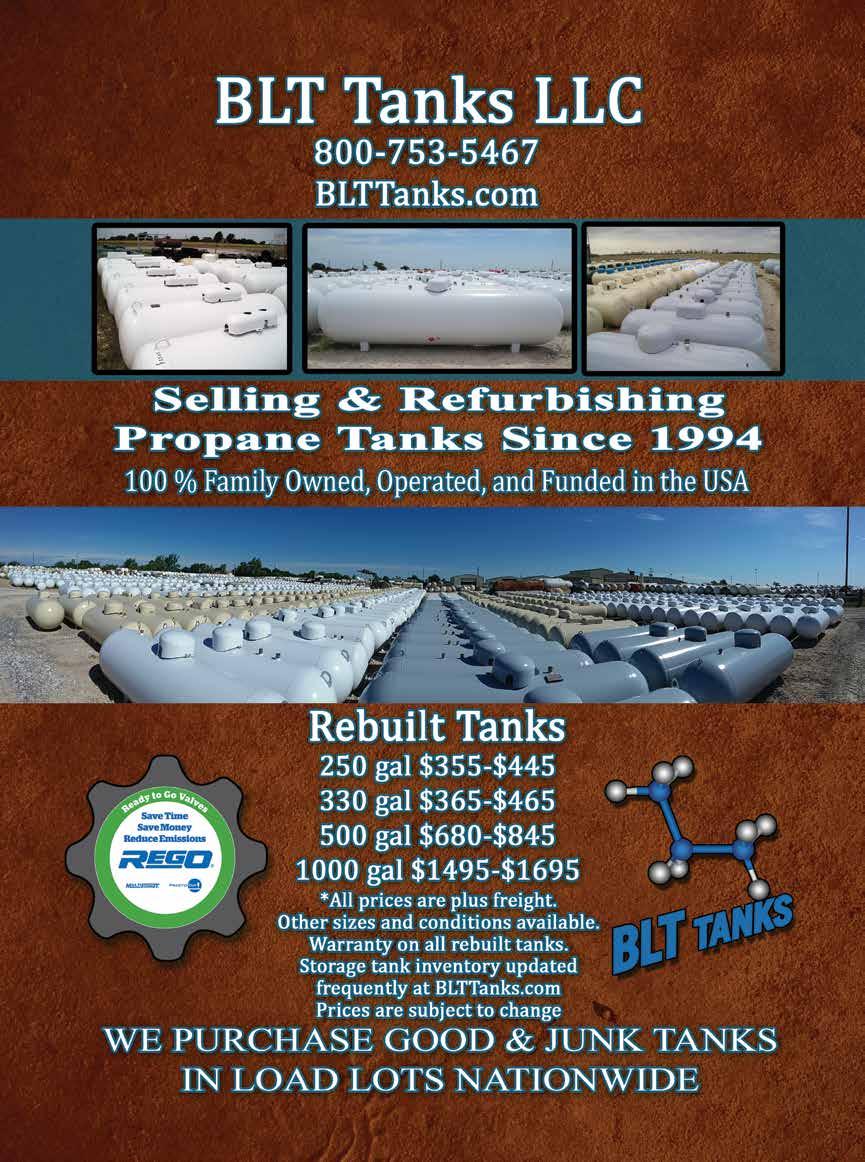
8 minute read
Propane Industry Survey Reveals Key Insights on Pay Benefits & Business Practices
See how you compare with other propane retailers in a study released by Gray, Gray and Gray
The beginning of the year is always a good time to take stock of where you’ve been and where you’re going. This holds true for your personal life (more fruit, fewer carbs!), and for your business.
Advertisement


Part of evaluating the health of your business is comparing it to similar businesses. How much are they paying? What troubles have they been having? How are they handling these problems?
While we don’t have the answers for your business, we will offer some reflection courtesy of a survey compiled and published by Gray, Gray & Gray, a national accounting and business advisory firm for the propane industry. The survey includes results for the whole country as well as regionally for the South.
Retaining Propane Employees
Finding and retaining good employees has always been the bedrock of any successful business. And those in the propane industry have not been immune to challenges the entire nation has been facing in finding candidates for their open positions. And keeping them. When asked how “Retaining good employees over the past year has been”, most survey respondents said that it was somewhat difficult (60%) and very difficult (14%). However, 25 percent of respondents said it was “easy”.
What are folks doing to retain employees? Nearly all respondents, 92%, cited raising wages. But there were many other ways employers approached retention: • Paying bonuses 65% • Health insurance 39% • Improving benefits 37% • Growth and promotion opportunities 28% • More input in management decisions 19%
Other things mentioned in retention efforts included increasing 401K/pension contributions (12%), converting hourly employees to salaried (6%), adding deferred compensation/ “golden handcuff” plans (3%), offering flexible scheduling during off-peak months, guaranteeing a minimum of 40 hours per week to hourly employees, morale boosting, and promoting a more family atmosphere.
When asked “What did you do this year to retain employees that you did not do last year?” respondents said some of the things they did differently included: increased wages, offered training, paid larger bonuses, increased paid time off (PTO), offered short term and long term disability insurance, and offered deferred compensation.
Finding New Employees
Finding qualified new employees over the past year has been a bit harder for the industry, with 28 percent saying it was “nearly impossible.” Almost half, 44 percent, said it was “very difficult”, followed by somewhat difficult (23%) and easy (5%).
Employers are using some of the same strategies for new employees as they did for retention, with 78 percent offering higher wages, 39 percent offering training programs, 23 percent offering flexible hours and 21 percent offering more benefits. Additionally, some offered signing bonuses (17%), more paid vacation time (18%), tuition reimbursement (15%), and other strategies (11%), which included on-the-job training, better screening and employee referrals.
Word of mouth referrals was by far the most successful way to find new employees (59%), followed by online websites like Monster or Indeed (37%) and social media posts (17%). Unfortunately, 11 percent of respondents said they had “no luck at all”.
Propane Operations & Customers
For those who grew their customer list in the previous year, they attributed their increase to better or more effective marketing (35%) or to a variety of reasons (53%), which included word of mouth,
What is the HOURLY rate you pay?
Delivery Drivers Service Technicians – Heating Service Technicians - Air Conditioning Dispatchers Service Manager Customer Service Representatives Accounts Payable/Receivable Staff CFO/Controller Bookkeeping/Accounting Manager General Manager Operations Manager Office Manager Sales Manager IT Manager HR Manager
great service, aggressive pricing, poor competitor service or area growth. Only a few grew due to better use of the internet/ecommerce (8%) or acquisition (4%).
If they lost customers in the previous year, the reasons were various: • Lost to competitor with lower prices (43%) • Lost due to other reasons (23%) (Sold/moved, natural gas, let them go, converted to electric heaters, and messed up) • Lost to heat pump conversion (20%) • Lost to gas conversion (12%) • Lost to competitor with similar pricing (2%)
In terms of how respondents qualified a customer as “lost” and removed them from their customer list: • After no deliveries in 12 months (32%) • When they notify us in writing (24%) • Other (When we pick up our equipment) (23%) • We never take customers off our customer list (17%) • After no payment in 12 months (4%)
The percentage of their customer list that is automatic customers is almost even, with 53% of customers as automatic customers and 47% will call.
Nationally, the percentage of active customers that use a budget plan is 17%. The percentage in the South is lower at 13%.
The percentage of active customers who use a price protection plan is 23% nationally and 20% in the South.
National South $23.51 $21.50 $25.35 $21.38 $27.58 $22.21 $24.39 $19.50 $33.45 $29.85 $19.44 $16.44 $21.01 $18.49 $49.37 $40.34 $27.07 $25.37 $46.83 $39.89 $37.91 $31.36 $30.92 $27.68 $37.58 $25.67 $34.58 $21.67 $33.88 $25.54
Those surveyed were asked specifically about their heating propane deliveries in terms of the average tank size and average gallons delivered. In the South, the tank sizes were half the size of the national average with a 250-gallon being the average residential tank and a 500-gallon the average commercial tank size (compared to a 500-gallon and 1,000-gallon nationally).
Residential average gallons delivered per stop was 171 nationally and 153 in the South. Commercial average gallons delivered per stop was 538 nationally and 388 in the South.
The average propane gallons delivered per stop was 171 (nationally) and 189 (South). Stops per hour were very similar, with 2.08 nationally and 1.94 in the South. Gallons per hour were almost identical with 356 gallons per hour nationally and 355 gallons per hour in the South.
Propane companies said they own 74 percent of the above ground tanks they utilize and 26 percent of the underground tanks. Most propane retailers (76%) charge annual rental fees for customer propane tanks. However, only 35 percent charged a delivery fee.
When asked “How many gallons are price-protected as a percentage of gallons sold?”, the majority of respondents said they utilized a variable price plan (73%), followed by a fixed price plan (24%) and a cap price plan (3%).
On tank monitoring, only 34 percent of survey respondents said they offered the service. 98 percent of those who offered tank monitoring would retrieve the system if they lost the customer.
Just over half of customers have multiyear contracts on propane tanks for above ground tanks (56%) and underground tanks (57%). The average length of the contract for both is 4 years.

Propane Business Changes
The entire business world has dealt with a host of business changes that have come about in the wake of the COVID-19 pandemic, with supply chain woes and inflation testing the mettle of even the most stable of industries. Outside of the payroll, the survey asked respondents to name what operating expenses have increased the most in the last one to two years. At the top of the list was health insurance
(77%), followed by vehicle cost (72%) and liability insurance (59%). Other areas targeted included updating software (33%), cybersecurity insurance (15%) and environmental (5%). Other things mentioned were supplies and fuel costs, cyber threats, tanks and freight expenses.
When asked “What are the three largest permanent business changes you have made in the last 12 months?” propane businesses in the South answered: • Upgrades - software, website, better routing system and tank monitors, processes • Increased wages, more bonuses, more flexibility on hours • Added positions - bobtail driver • Acquisitions, added second location or relocated
As cyber security has become a more dominant part of a propane industry member’s focus, the survey asked “How are you protecting your business against a cyberattack and data loss?”
The top response to this was to secure data backup for disaster recovery & business continuity (79%), followed by encrypted cloud-based data storage (66%), anti-malware software/endpoint protection (63%) and staff training (58%). Other things mentioned: cybersecurity insurance (34%) and written information security plan (WISP) (21%). Unfortunately, 5 percent of respondents said they were not sure what they should be doing.
Propane Business Plans
So what other things are on propane providers’ minds? The study asked “what products or services are you considering adding in 2022?” The top three responses were generators (36%), plumbing (32%) and HVAC (27%).
Most respondents also said they maintained their margins (62%) while adapting to the challenges posed by the Russia/ Ukraine conflict. However, 20 percent said they had lower margins as a result.
In terms of business retention, the survey asked, “If you lost customers last year, to what do you most attribute their leaving?” • Lost to competitor with lower prices 43% • Lost due to other reasons 23% • Lost to heat pump conversion 20% • Lost to gas conversion 12% • Lost to competitor with similar pricing 2%
In terms of changes respondents were considering for the coming years, acquiring a company was the most mentioned (40%), followed by developing a new bulk plant (34%) and transitioning to the next generation (31%). Other business changes being contemplated included updating accounting software (22%), conducting a business valuation (19%), retiring (16%), diversifying into a new product line (like generators, pest control or plumbing, etc.) (13%), selling their company (12%) and merging into a joint venture (3%).
In the South, 97% of propane retailers surveyed reported being members of their propane association. Did you know for 2023 90% of TPGA membership is tax deductible? Learn more about becoming a TPGA member by visiting us on the web at https://www.txpropane.com/why-join
These survey results are from the 2022 Propane Service Survey, published by Gray, Gray and Gray, a national accounting and business advisory firm for propane marketers. For more information on their firm, visit www.gggllp.com







